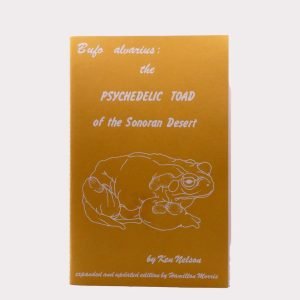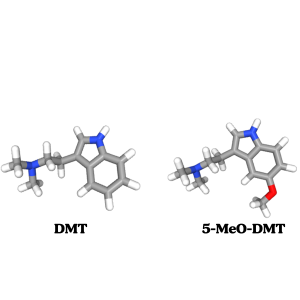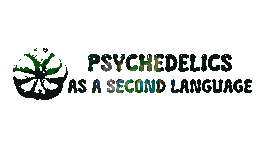DMT vs 5-MeO-DMT
Today, we live in an era of knowledge. Everything can be easily found on the internet, in the palm of our hands, via a mobile device or a computer. However, questions about psychedelics remain in our minds. With the rapid increase of information and popularity of these substances, you can easily misdirect yourself towards an unreliable source or face complicated data that one who’s just starting to learn about the subject may not understand.
With the popularization of terms such as “Toad Medicine” or “5-MeO”, people began to wonder about the differences between DMT and 5-MeO-DMT.
Generally, you might come across misinformation regarding the differences between the two. Because of its name, people believe that 5-MeO-DMT is just like DMT, and it all feels the same. “It’s all DMT at the end of the day.”
For this reason, we decided to cover the differences between DMT and 5-MeO-DMT.
To understand the differences between DMT and 5-MeO-DMT, we first need to know the origins and history of both compounds.
DMT or N, N-Dimethyltryptamine, is vastly found in nature as an alkaloid present in plants such as:
-
- Various citrus trees
-
- Phalaris
-
- Psychotria Viridis
-
- Acacia sp.
-
- Mimosa Hostilis
And additionally as a natural biosynthesis in animals and humans.
The human biosynthesis of DMT has been a topic of discussion over the years in the scientific world. Popularized by Rick Strassman, author of DMT: The Spirit Molecule, and backed up by many pseudoscientists and psychonauts, DMT was thought to be biosynthesized in the Pineal Gland, located where Hinduism would nominate “The Third Eye.” There is no scientific evidence that DMT is produced in the pineal gland. However, INMT (Indolethylamine N-methyltransferase), an enzyme required for the production of DMT, has been found in parts of the brain and the:
-
- Lungs
-
- Heart
-
- Adrenal Gland
-
- Pancreas
-
- Lymph Nodes
-
- Spinal Cord
-
- Placenta
-
- Thyroid
Its wide availability in nature allowed the substance to be found in 1931 by Richard Manske, and its hallucinogenic effects were described in 1956 by the chemist and psychiatrist Stephen Szara.
Szara extracted DMT from the Mimosa Hostilis rootbark and injected the extract into himself intramuscularly. This experience brought the eyes of Terence Mckenna to the substance. Terence became a spokesman for spreading the word about DMT during the 60s, thus becoming known for describing his experiences with the compound and his infamous speech about DMT machine elves.
Many followed the popularization of DMT and became interested in the molecule in between them, the previously mentioned Rick Strassman, with his book, Stanislav Grof, and Wim Hof, with the development of breathwork techniques that may increase the endogenous levels of DMT, and most recently, Andrew Gallimore with his book Alien Information Theory: Psychedelic Drug Technologies and the Cosmic Game, and the ongoing research conducted by Zeus Tipado and his team at Maastricht University with the studies of the effects of DMT combined with Virtual Reality and Extended Reality.
The history of 5-MeO-DMT isn’t as simple as the one of DMT. Originally, 5-MeO-DMT was used as a snuff by Indigenous tribes in Peru under the name of Yopo. Tribesman would grind the seeds of Anadenanthera Colubrina and use the material as a snuff.
Another 5-MeO-DMT containing snuff was also found in South America, this time in the depths of the Amazon Rainforest, this time using the plant Virola Theiodora.
As far as traditional use, history would end with the snuff practices done in South America. However, it was in the United States where things became mysterious with a pamphlet named Bufo Alvarius: The psychedelic toad of the Sonoran Desert, published in 1984 by a mysterious entity under the pseudonym Albert Most.

This time, we not only began to question who is Albert Most, but we found that Incilius Alvarius (Formerly known as Bufo Alvarius) produced not only bufotenine as an alkaloid of his milky venom as a defense mechanism but also 5-MeO-DMT, somewhat proving the long speculation of the anthropologist in the use of the intoxication ritual using toads of the Bufo genus by ancient people in Mesoamerica.
In his pamphlet, Albert Most (Al Most) described the habitat of the species, where to locate them, how to identify them, how to extract the venom from the toads without causing any harm, and the first time a human ever consumed the venom of Incillius Alvarius.
With the popularization of the Incilius Alvarius toad from Albert Most’s pamphlet, people began to drive to Sonora to extract the venom of the toads and capture them for personal benefit and as a business. Fast-forward to the present, little did people know the impact these actions would have on the Incilius Alvarius populations. Plenty of toads are run over as they find their source of food, insects attracted by the headlights of cars passing in the region of Sonora. Today, Incilius Alvarius is considered an endangered species, and many have joined the Sonora Desert Toad movement, promoting synthetic 5-MeO-DMT instead of using the toad’s venom.
The question of who is this mysterious Albert Most character remained until 2021 when a journalistic investigation led by the journalist and chemist Hamilton Morris identified the true identity of Albert Most, Ken Nelson.
After his identification, Hamilton Morris partnered with Cream Forever in Arizona to recreate and expand the original pamphlet published in 1984, using the original designs done by Gail Patterson, referring to the current issues regarding the endangerment of the species, alongside a synthesis route using a metabolite of melatonin, 5-Methoxytryptamine.

Now that we know the history and origins of both substances, what are their differences?
5-MeO-DMT was first synthesized by Toshio Hoshino and Kenya Shimodaira in 1936. The substance is an analogue of DMT with a methoxy group in the fifth carbon, hence its nomenclature.

On paper, the difference is minimal. However, the ones who have experimented with both compounds can say that these substances behave differently depending on dosage and method of consumption.
These substances can be consumed:
-
- Orally, if taken with an MAOI.
-
- Smoked and vaporized if in a crystalized form or dried toad venom.
-
- As a snuff in the case of 5-MeO-DMT
-
- Injected intramuscularly and intravenously in the case of DMT.
Just like every substance, both of these compounds have methods of consumption that have become more popular than others.
In the case of DMT, the most popular method of consumption is the traditional method, orally as a brew traditionally known as Ayahuasca, usually containing an MAOI, that being the beta-carbolines present in the Ayahuasca vine (Banisteriopsis caapi) and a DMT-rich plant, usually Psychotria Viridis (Chacruna). The mixture of the plant is left to boiling point for hours by a shaman and given to those willing to experiment, lasting for approximately 6 hours after being metabolized.
This method has also brought some dilemmas when it comes to experimenting with Ayahuasca. Considering that Ayahuasca is a tea, one can brew it at home. Thus, the community splits on whether one can say they have tried Ayahuasca if they haven’t done it in a traditional setting but have instead done it in the comfort of their home.
Another method developed over the years Pharmahuasca, where one consumes a synthetic MAOI, followed by smoking/vaporizing synthetic DMT.
The most popular method amongst the psychonaut community would be smoking/vaporizing free-base DMT. This method became popularized for its short duration and coined DMT as the “Businessman’s trip” as the effects would last as long as a work break.
As for 5-MeO-DMT, not many methods of consumption have become popularized. In fact, I would dare to say almost no one consumes Yopo/Virola besides people living in the region where the snuffs were invented.
As sad as it sounds, the only popularized method is the consumption of Incilius Alvarius or “Toad Medicine” which is being explored by many celebrities, spreading the word in their social media, news, etc. Due to the previously mentioned endangerment of the Incilius Alvarius species, the Protect the Toad movement has presented a solution consuming a synthetic version of 5-MeO-DMT. However, this solution didn’t sit well with naturalists who believe a synthetic version of the compound cannot substitute Toad Venom, as the experience contains the spirit of the toad and thus cannot be replicated. These two different points of view brought the community to a collision on a Nature vs. Synthetic drug war, some protecting the Sonora desert toad and others claiming that extracting the toad from the venom does not cause any harm and that the experience cannot be replicated with a synthetic compound.
Despite their similarities, the experiences are subjectively different:
-
- 5-MeO-DMT has been described as a life-changing experience, as it can create ego dissolution, the feeling of unity with the universe and an unexplainable experience, often simplified as “Feeling God” or “Non-dual.”
-
- DMT is described as creating fractal visuals, and some get transported to an otherworldly experience and meet different creatures, DMT entities, coined by McKenna as “Mechanical Elves.”
Compared to DMT, 5-MeO-DMT is approximately 10 to 20 times more potent in humans. For this reason, DMT is generally taken at higher dosages.
Smoked/Vaporized doses:
When consumed orally, one won’t feel the psychedelic effects of 5-MeO-DMT and DMT, as the monoamine oxidase enzyme quickly breaks down. However, when they are paired with an MAOI (Monoamine oxidase inhibitor) or reversible inhibitor of monoamine oxidase A (RIMA), the psychedelic effects of these compounds are prolonged, which is why an Ayahuasca experience can last as long as 10 hours. However, this interaction also explains the danger of certain drug interactions.
Combining 5-MeO-DMT, DMT, and other substances or drugs that contain MAOIs or RIMAs, like SSRIs and certain antipsychotic drugs can be dangerous.
DMT and 5-MeO-DMT as potential pharmacological tools
Both compounds being tryptamines and indolamine metabolites of tryptophan, we can safely say that both compounds act on the serotonin 5HT receptors, more specifically as an agonist at the 5HT1-A/5HT2-A receptors.
Thus, allowing us to determine them as potential pharmacological tools!
-
- DMT has shown to be a potential tool not only for its neurogenesis and neuroprotective effects for stroke victims and neurodegenerative diseases but also due to its stimulation of the sigma-1 receptor, sparking interest in anti-inflammatory, immunomodulation treatments. Additionally, when consumed as a brew, the substance has been associated with improvements in depression, anxiety, and addiction.
Keep up with research being done on DMT at:
Small Pharma’s research on DMT for the treatment of Major Depressive Disorder
-
- 5-MeO-DMT can cause rapid and sustained effects in symptoms of depression, anxiety, and stress. Additionally, 5-MeO-DMT also stimulated the neuroendocrine function, immunoregulation, and anti-inflammatory processes, which may contribute to changes in mental health outcomes. (You can keep up to date with the clinical research done with 5-MeO-DMT at:
Why are these substances so effective when it comes to neuroplasticity?
BDNF, standing for Brain-derived neurotrophic factor, is one of the key neuroendocrine factors that modulate neuroplasticity. BDNF is crucial for the maintenance of brain homeostasis and in multiple neuropathologies. In multiple instances, psychedelics and related compounds have shown to be useful in modulating BDNF/Neurotrophin levels, thus alleviating the physiological, behavioral, and cognitive symptoms of neurogenerative disorders.
As mentioned, Ayahuasca’s primary psychoactive compound is DMT, a close analog of 5-MeO-DMT. Therefore, we can speculate that this compound may have systemic BDNF-modulatory and neuroplasticity-promoting effects in humans.
Dangers of DMT and 5-MeO-DMT:
DMT and consequently 5-MeO-DMT are structurally related to serotonin. It’s known that consuming substances directly related to serotonin might induce serotonin syndrome. Users currently taking antidepressants are at the highest risk for this complication.
Serotonin Syndrom occurs when the body accumulates an excessive amount of serotonin, leading to symptoms such as:
-
- agitation
-
- confusion
-
- high blood pressure
-
- loss of muscle coordination
-
- a headache
Both compounds can have serious consequences for those who have a pre-existing history of mental illnesses such as schizophrenia or a history of heart problems.
Additionally, as these compounds produce mild visual hallucinations, a user might be presented with imagery that may augment their trauma. For this reason, therapy retreats and clinics provide users with an integration process and constant support of the patient.
Learn more about integration and psychedelic therapy at:
https://lophophoraasl.com/harm-reduction-101-psychedelic-therapy-and-psychedelic-retreats/
DMT vs 5-MeO-DMT:
-
- 5-MeO-DMT has been described as a life-changing experience, as it can create ego dissolution, the feeling of unity with the universe and an unexplainable experience, often simplified as “Feeling God” or “Non-dual.”
-
- DMT is described as creating fractal visuals, and some get transported to an otherworldly experience and meet different creatures, DMT entities, coined by McKenna as “Mechanical Elves.”
-
- Compared to DMT, 5-MeO-DMT is approximately 10 to 20 times more potent in humans. For this reason, DMT is generally taken at higher dosages.
-
- DMT has shown to be a potential tool not only for its neurogenesis and neuroprotective effects for stroke victims and neurodegenerative diseases but also due to its stimulation of the sigma-1 receptor, sparking interest in anti-inflammatory, immunomodulation treatments. Additionally, when consumed as a brew, the substance has been associated with improvements in depression, anxiety, and addiction.
-
- 5-MeO-DMT can cause rapid and sustained effects in symptoms of depression, anxiety, and stress. Additionally, 5-MeO-DMT also stimulated the neuroendocrine function, immunoregulation, and anti-inflammatory processes, which may contribute to changes in mental health outcomes.


